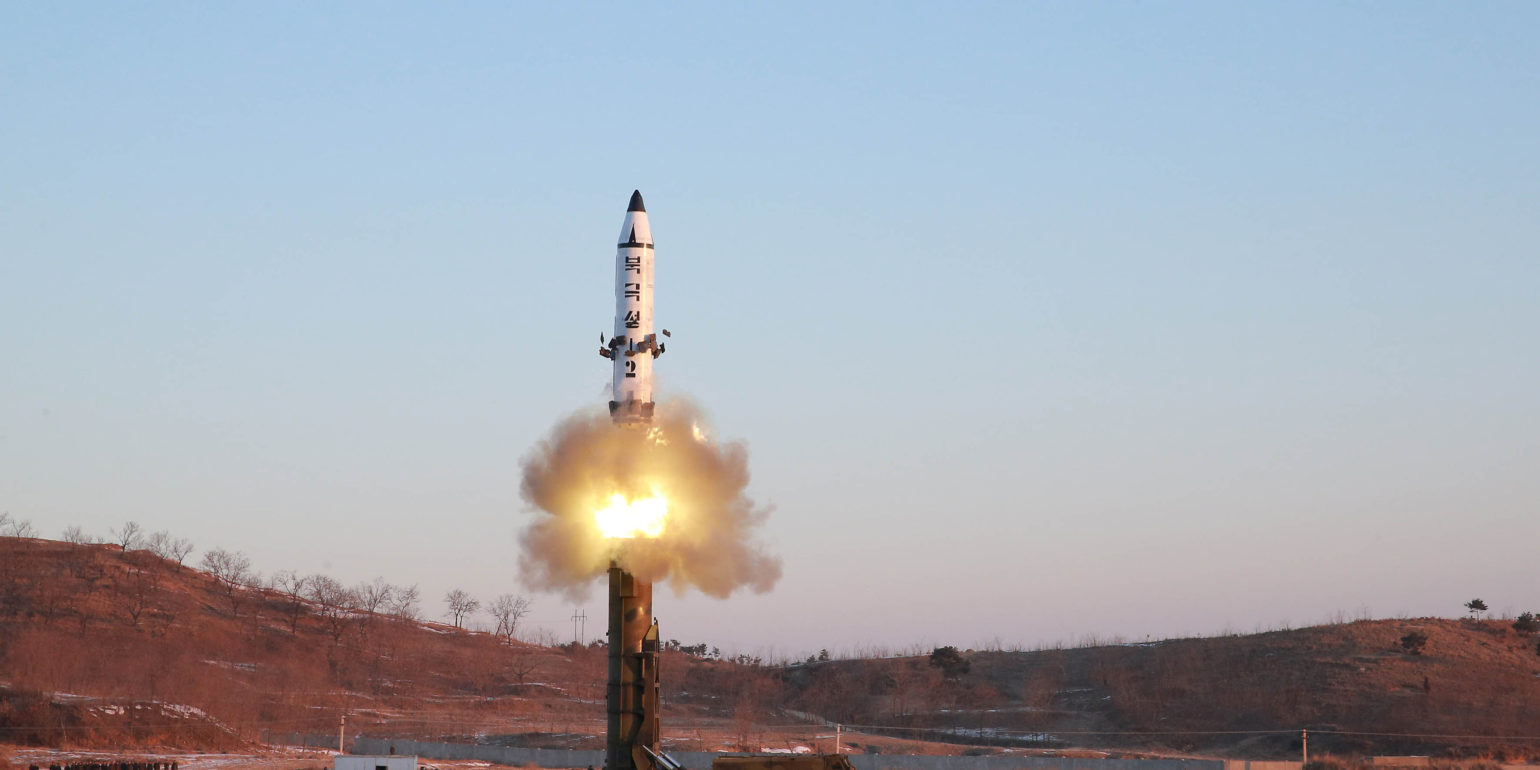Facts
| DPRK/U.S. Designation | Pukguksong-2/KN-15 |
| Missile Variants | KN-11/Polaris-1 (submarine-launched) |
| Mobility and Role | Road-mobile/Medium- or Intermediate-Range Ballistic Missile |
| Designer/Producer | Democratic People’s Republic of Korea |
| Range | 1,200-2000km |
| Warhead Type and Weight | Conventional/Nuclear |
| MIRV and Yield | No MIRV capabilities/Unknown |
| Guidance System/Accuracy | Inertial[i]/Unknown |
| Stages/Propellant | Two/Solid |
| IOC/Retirement | 2018-19 |
| Status/Number of Units | In Service |
Overview
A modification of the KN-11 submarine-launched ballistic missile (SLBM),[ii] also known as the Pukguksong-1 (Polaris-1), the Pukguksong-2 is a road-mobile, solid-fuel, medium- or intermediate-range ballistic missile (M/IRBM) first tested by the Democratic People’s Republic of Korea (DPRK) on February 12, 2017. It was again tested on May 21, 2017, which was announced as the final test for the system before entering service. According to a 2019 report by the United Nations Security Council, the Pukguksong-2 is deployed in the north, near the DPRK’s border with China, alongside the Hwasong-7.
Cold-launched from a tracked Transporter Erector Launcher (TEL), the Pukguksong-2 can be launched from various terrain in as little as five minutes and has an estimated range of 1,200km.[iii] While the Pukguksong-2 is deemed nuclear-capable,[iv] the missile’s potential yield is unknown. The approximate yield of the nuclear warhead tested by the DPRK in September 2016, which DPRK spokesmen asserted could be fixed to a ballistic missile, was 10kT.[v]
Strategic Implications
The Pukguksong-2 marks a significant advancement of the DPRK’s ballistic missile launch capabilities. As the DPRK’s longest-range solid-fuel missile,[vi] the Pukguksong-2 could likely encroach upon Japan’s exclusive economic zone when fired at full range.[vii] Additionally, the tracked TEL from which the Pukguksong-2 is launched marks a technological milestone. Rather than being limited to the DPRK’s estimated 724km of paved roads, the tracks expand the Pukguksong-2’s mobility to more than 24,000km of unpaved roads, as well as off-road terrain.[viii] This mobility greatly enhances the concealability of the Pukguksong-2, and, in combination with its nuclear capability and extended range, demonstrates an ever more lethal ballistic missile program.
Sources
[i] The DPRK’s state-owned news organization, Korean Central News Agency, claims the Polaris-2 possesses “position control and guidance” capabilities. See https://www.nknews.org/2017/02/n-korea-successfully-test-fired-medium-long-range-missile-kcna/.
[ii] John Schilling, “The Pukguksong-2: A Higher Degree of Mobility, Survivability and Responsiveness,” 38North, January 13, 2016, http://38north.org/2017/02/jschilling021317/.
[iii] Schilling, “The Pukguksong-2.”
[iv] Choe Sang-Hun and David E. Sanger, “North Korea Claims Progress on Long-Range Goal With Missile Test,” New York Times, February 13, 2017, https://www.nytimes.com/2017/02/13/world/asia/north-korea-missile-launch-success.html?_r=1.
[v] Norman Friedman, “What Would Deter North Korea’s Nuclear Weapons?” United States Naval Institute, Proceedings 142.11 (November 2016): 90-91.
[vi] Tara Copp, “Pentagon: North Korean missiles pose ‘clear, grave threat’ to US,” Stars and Stripes, February 13, 2017, https://www.stripes.com/news/pacific/pentagon-north-korean-missiles-pose-clear-grave-threat-to-us-1.453833.
[vii] Ankit Panda, “It Wasn’t an ICBM, But North Korea’s First Missile Test of 2017 Is a Big Deal,” The Diplomat, February 14, 2017, http://thediplomat.com/2017/02/it-wasnt-an-icbm-but-north-koreas-first-2017-missile-test-is-a-big-deal/.
[viii] Ibid.

